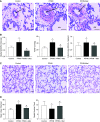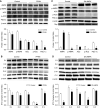AMP-Kinase Dysfunction Alters Notch Ligands to Impair Angiogenesis in Neonatal Pulmonary Hypertension
- PMID: 32048878
- PMCID: PMC7258820
- DOI: 10.1165/rcmb.2019-0275OC
AMP-Kinase Dysfunction Alters Notch Ligands to Impair Angiogenesis in Neonatal Pulmonary Hypertension
Abstract
Decreased angiogenesis contributes to persistent pulmonary hypertension of the newborn (PPHN); mechanisms remain unclear. AMPK (5'AMP activated protein kinase) is a key regulator of cell metabolism. We investigated the hypothesis that a decrease in AMPK function leads to mitochondrial dysfunction and altered balance of notch ligands delta-like 4 (DLL4) and Jagged 1 (Jag1) to impair angiogenesis in PPHN. Studies were done in fetal lambs with PPHN induced by prenatal ductus arteriosus constriction and gestation-matched control lambs. PPHN lambs were treated with saline or AMPK agonist metformin. Angiogenesis was assessed in lungs with micro-computed tomography angiography and histology. AMPK function; expression of mitochondrial electron transport chain (ETC) complex proteins I-V, Dll4, and Jag1; mitochondrial number; and in vitro angiogenesis function were assessed in pulmonary artery endothelial cells (PAEC) from control and PPHN lambs. AMPK function was decreased in PPHN PAEC and lung sections. Expression of mitochondrial transcription factor, PGC-1α, ETC complex proteins I-V, and mitochondrial number were decreased in PPHN. In vitro angiogenesis of PAEC and capillary number and vessel volume fraction in the lung were decreased in PPHN. Expression of DLL4 was increased and Jag1 was decreased in PAEC from PPHN lambs. AMPK agonists A769662 and metformin increased the mitochondrial complex proteins and number, in vitro angiogenesis, and Jag1 levels and decreased DLL4 levels in PPHN PAEC. Infusion of metformin in vivo increased the vessel density in PPHN lungs. Decreased AMPK function contributes to impaired angiogenesis in PPHN by altered balance of notch ligands in PPHN.
Keywords: endothelial cells; liver kinase B1; mitochondrial function; notch signaling.
Figures







References
-
- Levin DL, Heymann MA, Kitterman JA, Gregory GA, Phibbs RH, Rudolph AM. Persistent pulmonary hypertension of the newborn infant. J Pediatr. 1976;89:626–630. - PubMed
-
- Haworth SG, Reid L. Persistent fetal circulation: newly recognized structural features. J Pediatr. 1976;88:614–620. - PubMed
-
- Grover TR, Parker TA, Balasubramaniam V, Markham NE, Abman SH. Pulmonary hypertension impairs alveolarization and reduces lung growth in the ovine fetus. Am J Physiol Lung Cell Mol Physiol. 2005;288:L648–L654. - PubMed
Publication types
MeSH terms
Substances
Grants and funding
LinkOut - more resources
Full Text Sources
Medical

